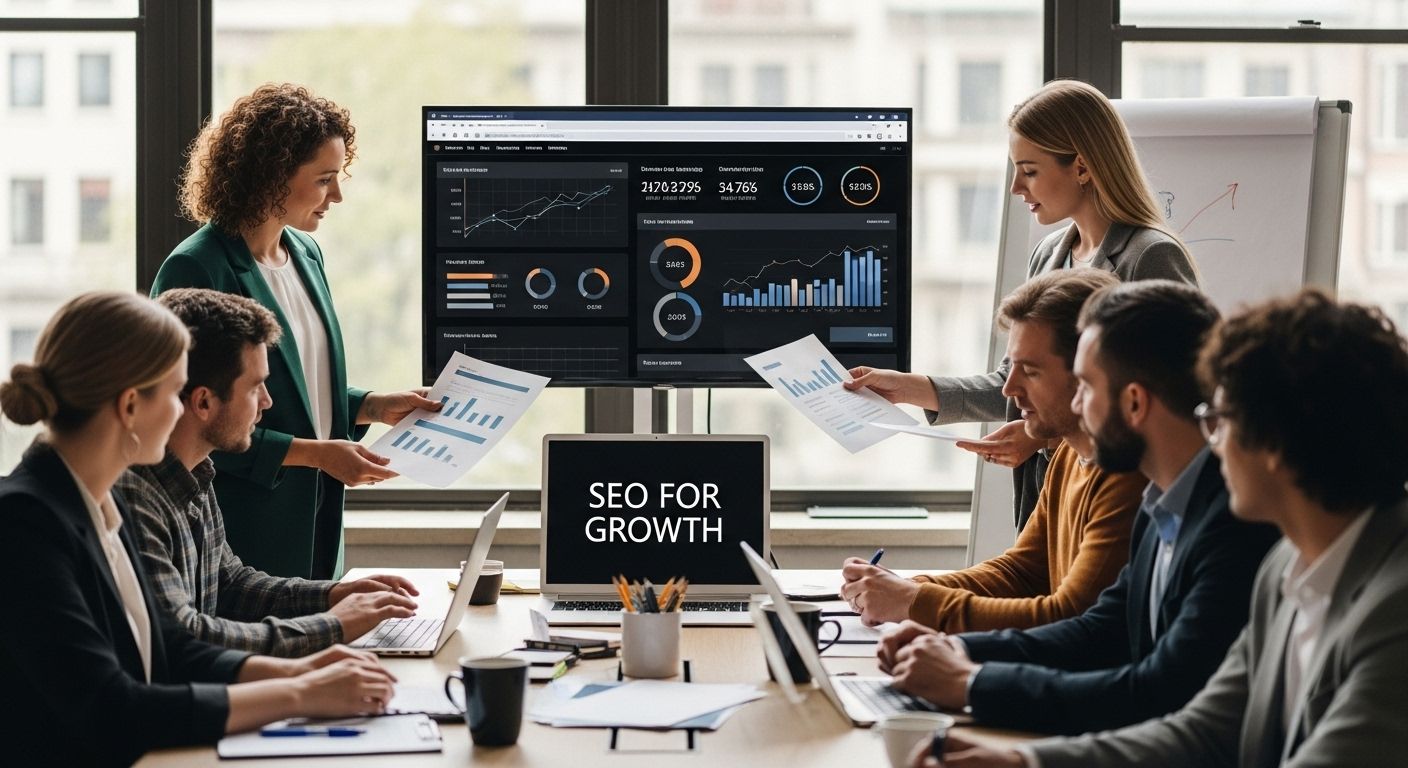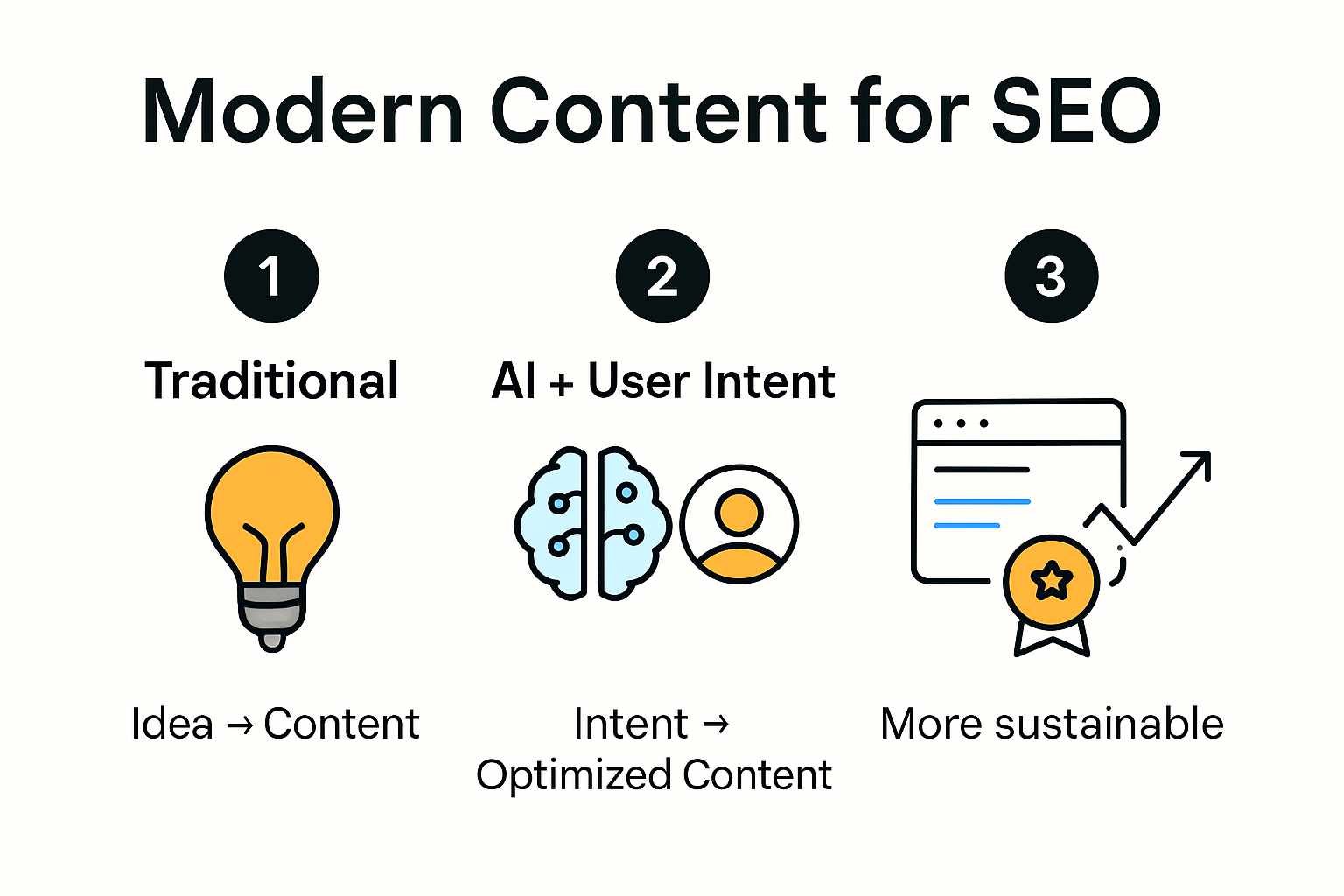How to Leverage SEO for Growth in 2025: Proven Strategies


SEO is no longer just a technical checklist for websites. Companies that harness SEO strategies in 2025 can see content marketing deliver three times more leads than traditional marketing while slashing costs by 62 percent. Most people think mastering keywords and technical fixes is all it takes. The real secret is in blending cutting-edge technology, user-focused content, and ongoing optimization to unlock continuous growth in an unpredictable digital world.
Table of Contents
- Understanding SEO's Role in Business Growth
- Building a Strong SEO Foundation in 2025
- Using Content and Keywords for Sustainable Growth
- Tracking Results and Optimizing Your SEO Strategy
Quick Summary
| Takeaway | Explanation |
|---|---|
| SEO is essential for business growth. | Effective SEO drives visibility, traffic, and conversions, making it crucial for businesses in the digital marketplace. |
| Create high-quality, relevant content. | Content should answer user questions and provide value, which aligns with search intent and enhances SEO performance. |
| Integrate technical and user experience optimization. | Ensure that websites are fast, mobile-responsive, and user-friendly to meet both search engine algorithms and user expectations. |
| Adapt to technological changes in SEO. | Stay updated with emerging search technologies and adjust strategies for content creation and optimization as needed. |
| Utilize advanced performance metrics. | Monitor key indicators like organic traffic and engagement to evaluate and refine SEO strategies effectively. |
Understanding SEO's Role in Business Growth
Search engine optimization (SEO) has transformed from a technical marketing tactic to a critical strategy for business growth. Companies now recognize that effective SEO directly impacts their ability to attract, engage, and convert potential customers in the digital marketplace.
The Strategic Importance of Search Visibility
Businesses today operate in an increasingly competitive online environment where visibility can make or break success. Research published in the American Journal of Interdisciplinary Studies analyzed 85 peer-reviewed articles and revealed that SEO significantly enhances digital visibility, leading to increased organic traffic and higher conversion rates. This is particularly crucial for small and medium-sized enterprises (SMEs) with limited marketing budgets.
The core mechanism of SEO involves optimizing web content to rank higher in search engine results pages (SERPs). When a website appears on the first page of Google search results, it gains substantial credibility and attracts more potential customers. Unlike paid advertising, which stops generating traffic when funding ends, SEO provides sustainable long-term growth.
Measuring SEO's Impact on Business Performance
Quantitative evidence demonstrates SEO's tangible business benefits. A case study from a private university in Sarajevo examined how improved search engine rankings directly correlate with increased website visits, longer user engagement, and higher conversion rates. The research highlighted that businesses implementing strategic SEO can expect significant improvements in their digital performance.
Key performance indicators for SEO success include:
- Organic Traffic: The number of visitors arriving through unpaid search results
- Conversion Rate: Percentage of visitors completing desired actions
- Keyword Rankings: Position of website pages for targeted search terms
- Bounce Rate: Percentage of visitors leaving the site quickly
Below is a table summarizing these key SEO performance indicators and their descriptions to help clarify what businesses should track.
| SEO Performance Indicator | What It Measures | Why It Matters |
|---|---|---|
| Organic Traffic | Number of unpaid search visitors | Shows your site's reach through SEO efforts |
| Conversion Rate | % of visitors completing desired actions | Indicates effectiveness in turning visitors into customers |
| Keyword Rankings | Position on SERPs for target terms | Reflects visibility and competitiveness in search |
| Bounce Rate | % of users leaving after one page | Signals if content and UX align with user intent |
Building a Sustainable Digital Presence
Successful SEO is not about quick tricks but developing a comprehensive strategy that aligns with user intent and search engine algorithms. This requires continuous optimization, content creation, and technical improvements. Businesses must focus on creating high-quality, relevant content that genuinely answers user questions and provides value.
The digital landscape continues to evolve, with search engines becoming more sophisticated in understanding user context and intent. Companies that invest in robust SEO strategies position themselves to adapt quickly, maintain competitive advantages, and drive sustainable business growth in an increasingly digital world.
Building a Strong SEO Foundation in 2025
Creating a robust SEO foundation requires a strategic approach that goes beyond traditional optimization techniques. In 2025, businesses must adapt to evolving search algorithms, technological advancements, and changing user behaviors to establish a competitive digital presence.
Embracing Technological Innovations in SEO
A groundbreaking study on White Hat Search Engine Optimization reveals the transformative potential of generative AI in creating more relevant and engaging content. This research highlights how artificial intelligence can help businesses develop more nuanced and user-focused content strategies. The key is not just to generate content but to create meaningful, contextually rich information that truly addresses user needs.Technical optimization remains critical. Websites must be lightning-fast, mobile-responsive, and provide seamless user experiences. The Digital Government Authority's 2024 guidelines emphasize the importance of creating websites that are not just search engine friendly but genuinely user-centric. This means focusing on:
- Page Speed: Ensuring rapid loading times across all devices
- Mobile Responsiveness: Creating adaptive designs that work perfectly on smartphones and tablets
- Clear Navigation: Developing intuitive site structures that help users find information quickly
The following table highlights three core elements of technical optimization and explains their impact on SEO and user experience.
| Technical SEO Element | Description | Impact on SEO & UX |
|---|---|---|
| Page Speed | Fast loading times on all devices | Improves rankings, reduces bounce |
| Mobile Responsiveness | Adapts layout for smartphones/tablets | Enhances mobile search visibility |
| Clear Navigation | Logical, intuitive site structure | Helps users find info, boosts engagement |
Content Strategy for Modern SEO
Content remains the cornerstone of effective SEO. However, 2025 demands a more sophisticated approach. It is no longer enough to simply produce keyword-rich text. Modern SEO requires creating comprehensive, authoritative content that demonstrates deep expertise and directly addresses user intent.
Businesses must develop content strategies that:
- Provide in-depth answers to user questions
- Incorporate multimedia elements
- Demonstrate expertise and credibility
- Align with user search behaviors

Technical SEO and User Experience Alignment
The most successful SEO strategies in 2025 will be those that seamlessly blend technical optimization with exceptional user experience. Research from higher education SEO experts underscores the critical nature of creating websites that are not just technically sound but genuinely helpful and engaging.
This means going beyond traditional metrics and focusing on:
- User engagement signals
- Content relevance
- Comprehensive information delivery
- Intuitive site architecture
Building a strong SEO foundation in 2025 is about creating a holistic digital strategy that considers technological capabilities, user needs, and search engine requirements. Businesses that can effectively integrate these elements will be best positioned to achieve sustainable online visibility and growth.
Using Content and Keywords for Sustainable Growth
Content and keywords represent the critical backbone of sustainable SEO growth. Strategic integration of these elements can transform a website from invisible to influential, driving organic traffic and establishing meaningful connections with target audiences.
Crafting Strategic Keyword Approaches
The U.S. Department of Energy's SEO guidelines emphasize the critical importance of incorporating keywords naturally within content. This means moving beyond simple keyword insertion to creating contextually rich, meaningful text that genuinely addresses user queries. The key is developing a nuanced approach that balances technical optimization with authentic communication.Effective keyword strategies now require understanding user intent rather than merely matching search terms. This involves:
- Semantic Relevance: Exploring related terms and concepts
- Long-Tail Keywords: Targeting specific, detailed search queries
- User Intent Mapping: Understanding the underlying motivation behind searches
Content Marketing as an SEO Catalyst
Research from Santa Clara University reveals a compelling statistic: content marketing generates approximately three times as many leads as traditional marketing while costing 62% less. This underscores the transformative potential of strategic content development.Successful content marketing for SEO involves:
- Creating comprehensive, authoritative content
- Addressing specific user questions and pain points
- Developing diverse content formats (blogs, case studies, videos)
- Maintaining consistent quality and relevance
Continuous Content Optimization
Search Engine Land recommends a dynamic approach to content strategy. This means continuously analyzing search trends, tracking content performance, and adapting strategies to evolving search algorithms.Key optimization techniques include:
- Regular content audits
- Performance metric tracking
- Adapting to emerging user search behaviors
- Refining keyword targeting based on real-world data
Sustainable growth in SEO is not about quick wins but building a robust, adaptive content ecosystem that consistently delivers value to users while remaining technically optimized for search engines. By integrating sophisticated keyword research, user-centric content creation, and ongoing optimization, businesses can develop a powerful digital presence that grows and evolves with their audience.
Tracking Results and Optimizing Your SEO Strategy
Tracking and optimizing SEO performance is a dynamic process that requires continuous monitoring, analysis, and strategic adjustments. In 2025, businesses must leverage advanced analytics and emerging technologies to gain meaningful insights and drive sustainable digital growth.
Advanced Performance Metrics and Analytics
Research from the White Hat Search Engine Optimization study highlights the transformative potential of generative AI in understanding and improving search engine rankings. Modern SEO tracking goes beyond traditional metrics, focusing on comprehensive performance indicators that provide a holistic view of digital visibility.Key performance metrics businesses should track include:
- Organic Traffic: Volume and quality of visitors from search engines
- Conversion Rates: Percentage of visitors completing desired actions
- Keyword Rankings: Position and visibility for target search terms
- User Engagement: Time spent on site, bounce rates, and interaction depth
Adapting to Emerging Search Technologies
The study on Generative Engine Optimization introduces groundbreaking insights into content visibility in new search paradigms. This research emphasizes the need for businesses to develop adaptive strategies that can quickly respond to technological shifts in search engine algorithms and user behavior.Strategies for staying ahead include:
- Continuous learning about emerging search technologies
- Experimenting with AI-powered content optimization
- Monitoring changes in search engine algorithms
- Developing flexible content strategies
Privacy and Tracking Considerations
Research on web tracking mechanisms reveals the complex landscape of user data monitoring and privacy regulations. Businesses must balance the need for comprehensive analytics with ethical data collection practices and user privacy protections.Essential considerations for responsible tracking include:
- Implementing transparent data collection policies
- Ensuring compliance with privacy regulations
- Using anonymized and aggregated data
- Prioritizing user consent and data protection
Below is a summary table listing key privacy and web analytics practices for SEO in 2025, along with their purpose to help maintain user trust and regulatory compliance.
| Practice | Description | Purpose |
|---|---|---|
| Transparent Data Collection | Clearly inform users about data gathered | Build trust, enhance consent |
| Privacy Regulation Compliance | Follow GDPR, CCPA, and relevant laws | Avoid fines, stay compliant |
| Data Anonymization | Remove personal identifiers from analytics | Protect user privacy |
| User Consent Prioritization | Obtain clear consent for tracking | Meet legal and ethical standards |
Successful SEO optimization in 2025 requires a multifaceted approach that combines advanced analytics, technological adaptability, and a commitment to user-centric strategies. By developing a nuanced understanding of performance metrics, embracing emerging technologies, and maintaining ethical tracking practices, businesses can create a robust and sustainable digital presence that continuously evolves with the changing digital ecosystem.

Frequently Asked Questions
What is the importance of SEO for business growth in 2025?
Effective SEO is crucial for driving visibility, traffic, and conversions, enabling businesses to build sustainable growth in a competitive digital marketplace.
How can I measure the impact of my SEO strategy?
Key performance indicators for SEO success include organic traffic, conversion rates, keyword rankings, and bounce rates, which help assess the effectiveness of your strategies.
What role does content play in modern SEO?
High-quality, relevant content is essential for modern SEO as it must align with user intent, answer questions, and provide value to enhance search visibility and engagement.
How should businesses adapt to technological changes in SEO?
Businesses should stay updated with emerging search technologies, continuously refine their content strategies, and implement best practices in technical optimization to maintain competitive advantages.
Turn SEO Insights Into Action With AI-Powered Content
You have learned how a modern SEO approach in 2025 requires more than technical know-how. Sustained growth means understanding search intent, creating high-quality content, using advanced analytics, and adapting to new technologies. Yet, finding time and resources for continuous content creation and optimization can hold your business back. Many businesses struggle to keep up with changing algorithms, user demands, and the need for a strategy that combines automated efficiency with real human insight.

BabyLoveGrowth.ai tackles these SEO pain points by providing a seamless solution for small businesses, digital marketers, and SEO specialists. Our AI-driven platform starts with a deep business and competition analysis, builds a tailored 30-day content plan, and generates SEO-optimized articles automatically. Let your business stay visible and relevant while saving time and focusing on what matters. Discover how easy growth can be by visiting BabyLoveGrowth.ai and unlock your path to higher rankings and stronger organic traffic today. Take the first step toward an unstoppable SEO strategy now.
Recommended
Smart SEO,
Faster Growth!
Most Read Articles

Generative Engine Optimization (GEO)
Learn how Generative Engine Optimization (GEO) helps your content rank in AI search engines like ChatGPT and Google AI. This comprehensive guide explains the differences between SEO and GEO, why it matters for your business, and practical steps to implement GEO strategies for better visibility in AI-generated responses.

Track LLM Traffic in Google Analytics 4 (GA4)
Learn how to track and analyze traffic from AI sources like ChatGPT, Claude, Perplexity, and Google Gemini in Google Analytics 4. This step-by-step guide shows you how to set up custom filters to monitor AI-driven traffic and make data-driven decisions for your content strategy.

How to Humanize AI Text with Instructions
Learn practical techniques to make AI-generated content sound more natural and human. This guide covers active voice, direct addressing, concise writing, and other proven strategies to transform robotic text into engaging content.

Open AI Revenue and Statistics (2024)
Comprehensive analysis of OpenAI financial performance, user engagement, and market position in 2023. Discover key statistics including $20B valuation, $1B projected revenue, and 100M+ monthly active users.